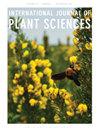草地恢复增加了土壤生物群为植物提供的互惠利益
IF 1.5
3区 生物学
Q3 PLANT SCIENCES
引用次数: 1
摘要
研究的前提。许多植物物种与土壤生物群如丛枝菌根(AM)真菌和根瘤菌进行互利共生。化肥施用和耕作等农业实践会降低土壤生物群的共生功能,但农业用地的恢复是否会导致土壤生物群的共生功能增加的研究并不多见。方法。为了评估农业土地的生态恢复是否会增加土壤生物群对植物的互惠效益,我们在一个共同的背景土壤中种植了一种对菌根和根瘤菌敏感的寄主植物(三叶草),该寄主植物接种了过去9-12年恢复的草原和邻近的耕地的土壤生物群。由于AM真菌和根瘤菌都是营养共生体,我们在低肥和高肥两种土壤生物群处理下种植植物,以评估当养分有效性高时,互惠服务是否会减少。关键的结果。与耕地相比,接种恢复草地土壤生物群可使地上植物生物量增加约19%,且在高、低施肥水平下均有显著的正效应。在低肥处理下,草地恢复处理AM真菌的根定植率是大田接种处理的1.8倍,而高肥处理AM真菌的根定植率没有差异。在两种肥料处理下,恢复草地和栽培地的根瘤菌根结瘤量没有差异。结论。这些结果表明,退耕还草后土壤生物群落的互惠效益会增加。土壤生物群对植物生物量的积极影响很可能是由AM真菌而不是根瘤菌引起的。土壤生物群所提供的互惠利益的增加可在原耕地草地恢复后的十年内发生。本文章由计算机程序翻译,如有差异,请以英文原文为准。
Grassland Restoration Increases Mutualistic Benefits That Soil Biota Provide to Plants
Premise of research. Many plant species engage in mutualistic symbioses with soil biota such as arbuscular mycorrhizal (AM) fungi and rhizobium bacteria. Agricultural practices such as chemical fertilizer application and tilling can decrease the mutualistic functions of soil biota, but whether restoration of agricultural lands causes soil biota to increase mutualistic functions is not frequently studied. Methodology. To evaluate whether ecological restoration of agricultural lands increases mutualistic benefits that soil biota provide to plants, we grew a mycorrhizal- and rhizobium-responsive host plant (Trifolium pratense) in a common background soil that had been inoculated with soil biota from grasslands that had been restored in the past 9–12 yr and adjacent cultivated fields. Because both AM fungi and rhizobium are nutritional symbionts, we grew plants in each soil biota treatment under both low- and high-fertilizer amendments to assess whether mutualistic services would be reduced when nutrient availability was high. Pivotal results. Inoculation with soil biota from restored grasslands increased aboveground plant biomass by ~19% compared with cultivated fields, and this positive effect was observed at both low and high fertilizer levels. In the low-fertilizer treatment, percentage colonization of roots by AM fungi was 1.8 times higher in treatments receiving restored grassland versus cultivated field inoculum, but there was no difference in AM fungal colonization under high-fertilizer treatments. Rhizobium nodulation of roots did not differ between restored grassland and cultivated field inoculum sources in either fertilizer treatment. Conclusions. These results show that the mutualistic benefits of soil biota can increase following the restoration of previously cultivated fields to grasslands. The positive effect of soil biota on plant biomass was most likely caused by AM fungi rather than rhizobium bacteria. Increases in mutualistic benefits provided by soil biota can occur within a decade following grassland restoration of formerly cultivated agricultural fields.
求助全文
通过发布文献求助,成功后即可免费获取论文全文。
去求助
来源期刊
CiteScore
4.50
自引率
4.30%
发文量
65
审稿时长
6-12 weeks
期刊介绍:
The International Journal of Plant Sciences has a distinguished history of publishing research in the plant sciences since 1875. IJPS presents high quality, original, peer-reviewed research from laboratories around the world in all areas of the plant sciences. Topics covered range from genetics and genomics, developmental and cell biology, biochemistry and physiology, to morphology and anatomy, systematics, evolution, paleobotany, plant-microbe interactions, and ecology. IJPS does NOT publish papers on agriculture or crop improvement. In addition to full-length research papers, IJPS publishes review articles, including the open access Coulter Reviews, rapid communications, and perspectives. IJPS welcomes contributions that present evaluations and new perspectives on areas of current interest in plant biology. IJPS publishes nine issues per year and regularly features special issues on topics of particular interest, including new and exciting research originally presented at major botanical conferences.

 求助内容:
求助内容: 应助结果提醒方式:
应助结果提醒方式:


